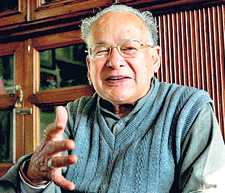KATHMANDU, (AFP) - As Haiti counts the cost of last month's devastating earthquake, experts are warning of the potential for an even greater disaster in another of the world's poorest countries, Nepal.
Geologists say it is only a matter of time before a major earthquake hits Nepal's densely populated capital Kathmandu, where 2.5 million people live in cramped, poorly-built housing with little or no awareness of the dangers.
Nepal sits on the border between two huge plates that have moved together over millions of years to form the Himalayas.
 |
| Nepalese man Mohan Bikram Thapa gestures as he recounts his earthquake experiences to AFP during an interview in Kathmandu. AFP |
Geologists believe it is at risk from an earthquake with a magnitude of around eight -- 10 times as powerful as the Haiti shock that killed more than 212,000 people.
Nepal has not suffered a major quake for decades, and expert David Petley believes the troubled country is woefully unprepared.
"From a geological perspective the risk seems to be very large indeed,"said Petley, Wilson professor of hazard and risk at Britain's Durham University.
"The area to the west of Kathmandu is undergoing the processes that drive earthquakes, and there has not been a quake on that section of the fault for hundreds of years.
"The larger the time gap (between quakes) the larger the quake is going to be."Many other major cities in the region are vulnerable to large earthquakes.
But a 2001 study by GeoHazards International, a US research group set up to reduce the human impact of natural disasters, found Kathmandu would suffer the worst losses.
Very low building standards, weak infrastructure and the fact that Kathmandu is built on the soft sediment of a former lake bed all contribute to the high risk level.
Like Port au Prince, Kathmandu is served by just one single-runway airport, but unlike the Haitian capital it has no port, and experts believe the only three roads into the city would likely be destroyed in a major quake.
A decade-long civil war and years of political instability have also taken their toll on Nepal, whose capital Kathmandu has just eight working fire engines.
Experts warn that few of the hospitals and government buildings could withstand a major quake. "What has been made clear in Haiti is that when a quake affects the capital and government infrastructure is destroyed, organising help becomes very difficult indeed," said Petley.
Geologist Amod Mani Dixit was working for the Nepal government on landslide prevention in 1988 when a 6.5-magnitude earthquake struck the east of the country.
The high death toll and damage caused by the quake prompted him to set up the National Society for Earthquake Technology (NSET) to raise public awareness of the dangers and help make schools and hospitals safer.
"It was a moderate earthquake, but the impact was huge. It killed 720 people and caused five billion rupees (67 million dollars) worth of damage, 25 percent of Nepal's GDP for that year," said Dixit.
"I was shocked. If even a moderate quake like that could cause such large amounts of damage, the question was what had we failed to do."After discovering that none of Nepal's government schools had been built to withstand quakes, Dixit launched a programme to make school buildings more earthquake-resistant.
His organisation is retro-fitting around five schools a year to strengthen them against quake damage, and he also runs training for masons on constructing quake-resistant buildings.
But he says much more needs to be done in Nepal, where awareness of the risk remains very low.
"It's not just buildings, but also a lack of knowledge that kills. Mindsets and practices need to be changed," he said. "Awareness levels have increased tremendously in the past 10 years, but it is not enough. Nepal is a fatalistic country and to bring people out of their slumber takes time."In 2003 the government introduced building codes to try to improve standards in construction, and now runs training for masons.
But Amrit Man Tuladhar, head of the Nepal government's earthquake preparedness programme, admits the regulations are often ignored, and says the older buildings in Kathmandu are a cause for concern.
"We believe more than 80 percent of old buildings could collapse," he said.
"Many of the buildings in the Kathmandu Valley are very old. If a quake struck at night, people would not be able to escape their houses."The last major earthquake to hit Nepal struck to the east of the capital in 1934. It measured 8.4 on the Richter scale and killed more than 8,500 people in Nepal and neighbouring India.
Mohan Bikram Thapa was living in Kathmandu with his parents when it hit and, 76 years on, he still remembers the massive devastation it caused.
"Suddenly everything began to shake and the houses started collapsing, filling the air with dust," recalls Thapa, 86. "All the tallest buildings fell into pieces."Later, at about five o'clock, people started bringing out the dead bodies to be burned.
"In those days, Kathmandu was like a small village. If the same thing happened now, it would be very dangerous." |



